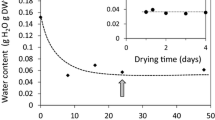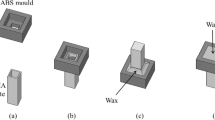Abstract
The viability and various physiological characteristics of individual sporangiospores of Rhizopus oligosporus in tempe starter cultures that had been stored for 8, 10, 16 and 30 months were examined by flow cytometry in combination with fluorescent dyes. Besides live, dead, and dormant spores we distinguished a category of sublethally damaged spores. Results indicated that the shelf-life of tempe starters was not limited by the death of spores, but by sublethal damage to spores as well as by dormancy which can be overcome by resuscitation, respiratory activation. During storage, the number of dormant and sublethally damaged spores increased: the longer the starter cultures were stored, the less dormant spores could still be activated. In contrast, the transition from sublethally damaged (spores that are not able to transform cFDA and emit green fluorescence except by activation treatment) to activated spores did not decrease with longer storage. However, after very long (30 months) storage, sublethally damaged spores could still be activated but could not germinate anymore. The shelf-life of spores in tempe starter is related to the physiological state of spores being sublethally damaged; a mechanism of physiological state transitions of R. oligosporus sporangiospores is proposed.
Similar content being viewed by others
Abbreviations
- cFDA:
-
carboxyfluoresceindiacetate
- FCM:
-
flow cytometry
- PI:
-
propidium iodide
- TOTO-1:
-
1-(4,4,7,7-tetramethyl-4,7-diazaundecamethylene)-bis-4-[3-methyl-2,3dihydro (benzo-1,3-oxazole)-2-methylidene]-1-(3-trimethyl ammonium propyl)-pyridinium tetraiodide
References
Ben Amor K, Breeuwer P, Verbaarschot P, Rombouts FM, Akkermans ADL, De Vos WM, Abee T (2002) Multiparametric flow cytometry and cell sorting for the assessment of viable, injured, and dead Bifidobacterium cells during bile salt stress. Appl Environ Microbiol 68:5209–5216
Breeuwer P, Abee T (2000) Assessment of viability of microorganisms employing fluorescence techniques. Int J Food Microbiol 55:193–200
Breeuwer P, De Reu JC, Drocourt J-L, Rombouts FM, Abee T (1997) Nonanoic acid, a fungal self-inhibitor, prevents germination of Rhizopus oligosporus sporangiospores by dissipation of the pH gradient. Appl Environ Microbiol 63:178–185
Bunthof CJ, Abee T (2002) Development of a flow cytometric method to analyze subpopulations of bacteria in probiotic products and dairy starters. Appl Environ Microbiol 68:2934–2942
Bunthof CJ, Bloemen K, Breeuwer P, Rombouts FM, Abee T (2001) Flow cytometric assessment of viability of lactic acid bacteria. Appl Environ Microbiol 67:2326–2335
Chitarra GS, Breeuwer P, Nout MJR, van Aelst AC, Rombouts FM, Abee T (2003) An antifungal compound by Bacillus subtilis YM 10-20 inhibits germination of Penicillium roqueforti conidiospores. J Appl Microbiol 94:159–166
Chitarra LG, Van den Bulk RW (2003) The application of flow cytometry and fluorescent probe technology for detection and assessment of viability of plant pathogenicbacteria. Eur J Plant Pathol 109:407–417
Davey HM, Kell DB (1996) Flow cytometry and cell sorting of heterogeneous microbial populations: the importance of single-cell analyses. Microbiol Rev 60:641–696
Hirons GT, Fawcett JJ, Crissman HA (1994) TOTO and YOYO: new very bright fluorochromes for DNA content analyses by flow cytometry. Cytometry 15:129–140
Kaprelyants AS, Kell DB (1993) Dormancy in stationary-phase cultures of Micrococcus luteus: flow cytometric analysis of starvation and resuscitation. Appl Environ Microbiol 59:3187–3196
Kaprelyants AS, Gottschal JC, Kell DB (1993) Dormancy in nonsporulating bacteria. FEMS Microbiol Rev 104:271–286
Kaprelyants AS, Mukamolova GV, Kell DB (1994) Estimation of dormant Micrococcus luteus cells by penicillin lysis and by resuscitation in cell-free spent medium at high dilution. FEMS Microbiol Rev 115:347–352
Kaprelyants AS, Mukamolova GV, Davey HM, Kell DB (1996) Quantitative analysis of the physiological heterogeneity within starved cultures of Micrococcus luteus by flow cytometry and cell sorting. Appl Environ Microbiol 62:1311–1316
Kell DB, Kaprelyants AS, Weichart DH, Harwood CR, Barer MR (1998) Viability and activity in readily culturable bacteria: a review and discussion of the practical issues. Antonie van Leeuwenhoek 73:169–187
Lopez-Amoros R, Comas J, Vives-Rego J (1995) Flow cytometric assessment of Escherichia coli and Samonella typhimurium starvation-survival in seawater using rhodamine 123, propidium iodide, and oxonol. Appl Environ Microbiol 61:2521–2526
Mortimer FC, Mason DJ, Grant VA (2000) Flow cytometric monitoring of antibiotic-induced injury in Escherichia coli using cell-impermeant fluorescent probes. Antimicrob Agents Chemother 44:676–681
Novo DJ, Perlmutter NG, Hunt RH, Shapiro HM (2000) Multiparameter flow cytometric analysis of antibiotic effects on membrane potential, membrane permeability, and bacterial counts of Staphylococcus aureus and Micrococcus luteus. Antimicrob Agents Chemother 44:827–834
Ritz M, Tholozan JL, Federighi M, Pilet MF (2001) Morphological and physiological characterization of Listeria monocytogenes subjected to high hydrostatic pressure. Appl Environ Microbiol 67:2240–2247
Rusmin S, Ko SD (1974) Rice-grown Rhizopus oligosporus inoculum for tempeh fermentation. Appl Environ Microbiol 28:347–350
Shapiro HM (1995) Practical flow cytometry. Wiley-Liss, Inc., New York, NY
Thanh NV, Nout MJR (2002) Rhizopus oligosporus biomass, sporangiospore yield and viability as influenced by harvesting age and processing conditions. Food Microbiol 19:91–96
Thanh NV, Nout MJR (2004) Dormancy, activation and viability of Rhizopus oligosporus sporangiospores. Int J Food Microbiol 92:171–179
Thanh NV, Rombouts FM, Nout MJR (2005) Effect of individual amino acids and glucose on activation and germination of Rhizopus oligosporus sporangiospores in tempe starter. J Appl Microbiol 99:1204–1214
Ueckert JE, Breeuwer P, Abee T, Stephens P (1995) Flow cytometry applications in physiological study and detection of food-borne microorganisms. Int J Food Microbiol 28:317–326
Ueckert JE, Nebe von-Caron G, Bos AP, ter Steeg PF (1997) Flow cytometric analysis of Lactobacillus plantarum to monitor lag times, cell division and injury. Lett Appl Microbiol 25:295–299
Votyakova TV, Kaprelyants AS, Kell DB (1994) Influence of viable cells on the rescuscitation of dormant cells in Micrococcus luteus cultures held in an extended stationary phase; the population effect. Appl Environ Microbiol 60:3284–3291
Wang HL, Swain EW, Hesseltine CW (1975) Mass production of Rhizopus oligosporus spores and their application in tempeh fermentation. J Food Sci 40:168–170
Wu CH, Warren HL (1984) Natural autofluorescence in fungi, and its correlation with viability. Mycologia 76:1049–1058
Acknowledgements
This work was supported in part by IFS Grant No. C/3399-1. N.V. Thanh gratefully acknowledges receipt of the sandwich fellowship from the Netherlands organization for international cooperation in higher education (NUFFIC). The authors thank Patrick Verbaarschot (Laboratory of Entomology, Wageningen University) for his assistance with FCM analyses.
Author information
Authors and Affiliations
Corresponding author
Rights and permissions
About this article
Cite this article
Thanh, N.V., Rombouts, F.M. & Nout, M.R. Viability and physiological state transitions of Rhizopus oligosporus sporangiospores in tempe starter culture. Antonie van Leeuwenhoek 91, 35–44 (2007). https://doi.org/10.1007/s10482-006-9093-7
Received:
Accepted:
Published:
Issue Date:
DOI: https://doi.org/10.1007/s10482-006-9093-7




